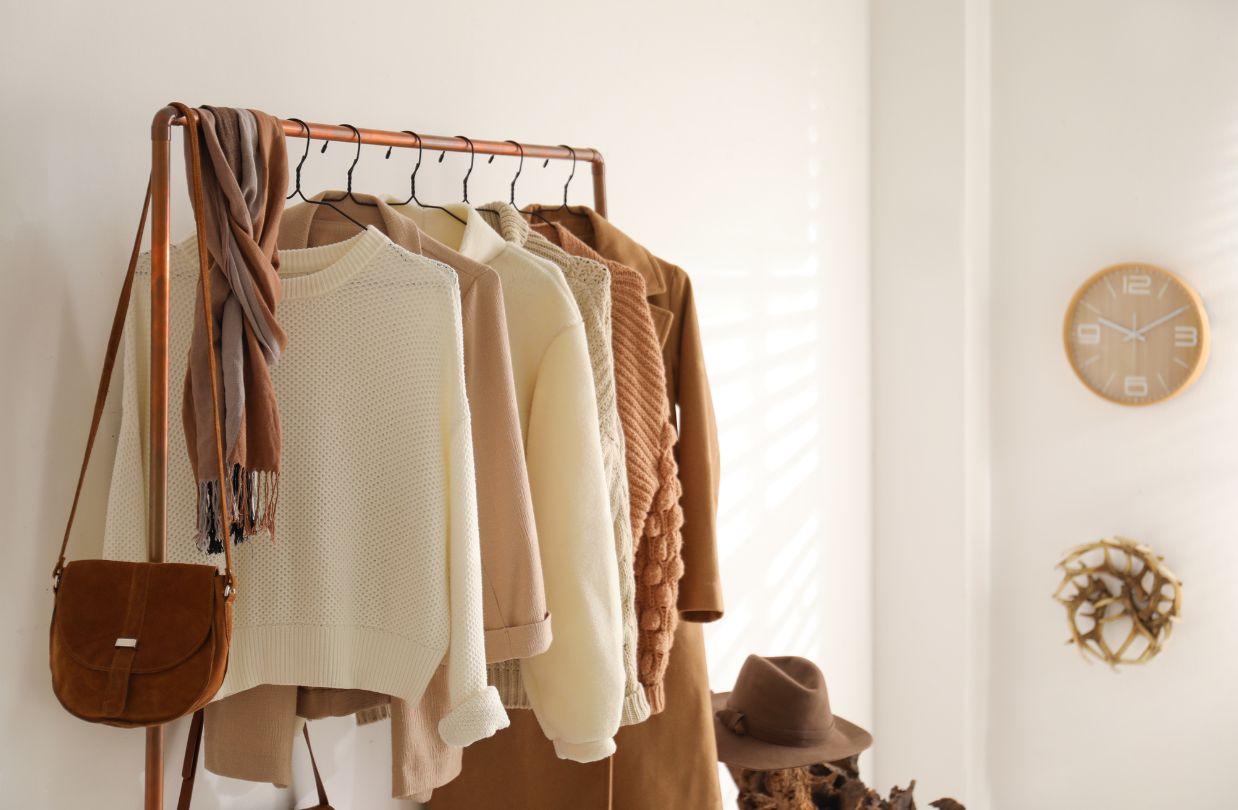These are the top essentials you need in your closet to make nursing – and postpartum recovery – more manageable and comfortable, all while staying stylish.
Building a capsule wardrobe for nursing can help make things easier postpartum and when you’re out and about with your new baby.
Plus, a nursing-friendly capsule wardrobe can help you get dressed for the day in less time (and energy), which are precious resources in postpartum.
This guide highlights our essentials for the perfect timeless (and seasonless) nursing capsule wardrobe.

What is a capsule wardrobe?
A capsule wardrobe is a curated selection of clothing pieces that all work together in various ways and complement each other. The goal of a capsule wardrobe is to create dozens of outfits from a limited number of items.
Since breastfeeding isn't forever, building a nursing capsule wardrobe is a great approach to help save money and ensure you’re both stylish and comfortable.
How many items should be in a capsule wardrobe?
Typically, a capsule wardrobe should have between 25 and 50 pieces of clothing.
Aim for 10-15 pieces for a nursing capsule wardrobe, keeping in mind you can additionally mix in what you already own.

Staying stylish while breastfeeding
A capsule wardrobe is an easier way to stay stylish while nursing and breastfeeding your baby. Personally, I was able to use a lot of what I already had in my closet, paired with some must-have nursing-friendly items.
For example, you can purchase a handful of nursing basics (think tanks, tees, and bras) and then layer in pieces already in your closet.
Add seasonal-appropriate, nursing-friendly pieces (like wraps, scarves, wrap dresses, etc.).
Are nursing clothes essential?
Yes, absolutely.
While you can get away with some wrap-front and button-down tops already in your closet, it’s essential to have at least a few pieces designed specifically for nursing, particularly a nursing bra and tank top.

Create a nursing capsule wardrobe in four steps
Creating a nursing capsule wardrobe is easy when you start with the essential nursing pieces (steps one and two).
Then, steps three and four will walk you through making your breastfeeding outfits stylish and comfortable.
Select your nursing bras
Add in nursing-friendly basics
Layer in fashion items from your closet
Swap out seasonal pieces as needed
After these four steps, you can add in any accessories (stay away from dangling earrings if your baby is grabby!), shoes, and bags to complete your nursing wardrobe.
1. Choose the right bras
There are two types of bras we’d recommend having for the foundation of your nursing capsule wardrobe:
The wrap-style bra will be your go-to for days at home and nighttime. The molded clip-down bra will be perfect under tees, tops, and dresses.
2. Add in basics
Tanks
Purchase a few nursing-friendly tanks to layer under the tops.
A tank layer can add an extra layer of privacy and comfort while nursing outside of your home.
How? Wear a tank under your shirt and lift the top shirt layer when it’s time to nurse your baby. Your tank will create more privacy and help you feel less exposed.
In addition to tanks, a stretchy belly band left over from pregnancy can be an easy option to add additional coverage while nursing. I loved using this while feeding and affectionately called it my "boob tube."
Tees
Nursing-friendly tees have either easy-access holes at the chest or a scoop or v-neck design, so you don’t have to lift your shirt to feed your baby. It’s helpful to have two tees in neutral colors, but it’s not necessary.
Tops
To get the most use out of them, have a few tops that aren’t necessarily designed for nursing but will work for it.
There’s a good chance you already have a few of these pieces—or something similar—in your closet.
3. Layer in items from your closet
Once you have the above items on hand, layer in essentials from your closet (or buy new, if needed), including:
Remember: when “shopping” in your closet while postpartum, your current size is probably different than what’s hanging in your closet.
If you have to buy new jeans or a new shirt, buy them in the size that fits you today. Not a size you “hope to be” in the future.
Much of postpartum is about acceptance, and that includes your changing body, too.
Read next: The Best Postpartum Jeans for Every Shape and Size
4. Swap seasonal items as needed
Depending on the time of year, some seasonal items and accessories are the perfect addition to your nursing capsule wardrobe, including:
Shop our nursing capsule wardrobe picks
More advice for your nursing capsule wardrobe
Ultimately, our top pieces of advice regarding a capsule wardrobe include:
Mix and match capsule clothing items
Buy what you fit into now
Get creative and experiment
Make changes as needed (and as you’re comfortable)
Stick to timeless styles for longevity
Don’t be afraid to experiment, mix and match, and get creative with your nursing wardrobe.
As you become more comfortable breastfeeding your baby, you might find that you have a wider variety of clothing you can wear and still nurse easily.
Also, make sure to purchase clothes you are comfortable wearing today. Your postpartum body is still healing, recovering, and adjusting to providing milk for your baby.
Buy clothes in the sizes that fit you now and help you feel confident in yourself.



